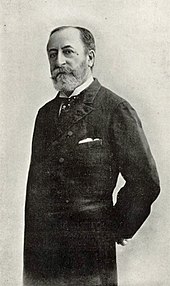
The Romance in D♭ major, Op. 37, is a composition by Camille Saint-Saëns for flute, accompanied by piano or orchestra, written in March 1871.
History
The piece was composed shortly after the Franco-Prussian War. After the Armistice of Versailles was signed on 28 January 1871, the Paris Commune assumed power in Paris on 18 March. Fearing for his safety, Saint-Saëns fled to exile in London. Under these extreme conditions, he wrote the Romance, an enchanting piece that seems to be musically undisturbed by the circumstances of composition. [1]
The piece was dedicated to Amédée de Vroye, a then well-known flautist. Because of political upheaval in France, the work was premiered by de Vroye and Saint-Saëns in mid-1871 in Baden-Baden, Germany. [1] The Paris premiere was given by Paul Taffanel and Saint-Saëns at a Société nationale de musique concert at the Salle Pleyel on 6 April 1872. Saint-Saëns was a close friend of Taffanel, even becoming godfather to his daughter. Taffanel would become the Romance's real champion, performing it numerous times over the years. [2] [3]
Music
| External audio | |
|---|---|
| Romance, Op. 37 | |
Saint-Saëns composed six chamber music works titled Romance – the instrumental romance in three-part song form had gained significance from the 1860s onwards as the transcription of the extremely popular vocal romance. [1]
The work is scored for flute and piano, with a version for flute and an orchestra consisting of 2 oboes, 2 clarinets in A, 2 bassoons, 4 horns (2 natural, 2 chromatic), 2 trumpets in D, timpani, and strings. [2] The orchestral version was presumably planned from the outset. [1] The work was also arranged for clarinet and piano by Alfred Piguet in 1907. [2]
The Romance is a short piece at around six minutes. Edward Blakeman writes: "The Romance is a slight piece, but bewitchingly atmospheric. It spins an expressive line with the direct, unsentimental appeal of a lyrical mélodie." [3] Today it is one of the more popular minor works by the composer and has established itself as part of the flute's core repertoire. [1]
References
- ^ a b c d e Jost, Peter, ed. (2019). Camille Saint-Saëns. Romance D flat major op. 37 for Flute and Piano. Munich: G. Henle Verlag. pp. III–IV. ISMN 979-0-2018-1354-7.
- ^ a b c Ratner, Sabina Teller (2002). Camille Saint-Saëns, 1835–1922: A Thematic Catalogue of his Complete Works, Volume 1: The Instrumental Works. Oxford: Oxford University Press. pp. 360–362. ISBN 978-0-19-816320-6.
- ^ a b Blakeman, Edward (2005). Taffanel: Genius of the Flute. Oxford: Oxford University Press. pp. 44, 99. ISBN 0-19-517098-9.